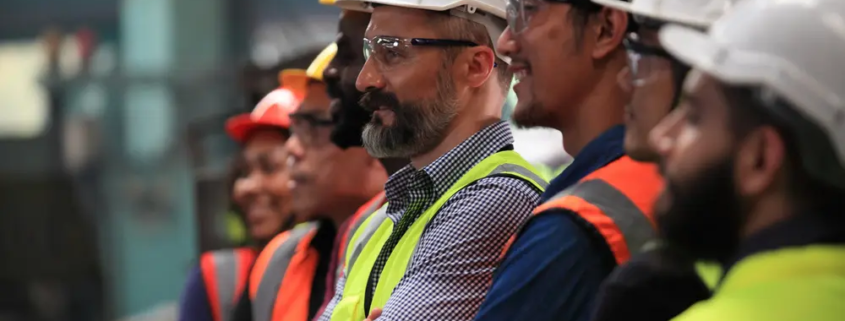By Dee-Ann Durbin and Anne D’Innocenzio | Originally posted on apnews.com
Steel and aluminum are ubiquitous in Americans’ lives. A stainless steel refrigerator holds aluminum soda cans. A stainless steel drum tumbles inside an aluminum washing machine. They’re the metals used in cars and airplanes, phones and frying pans, skyscrapers and zippers.
That’s why President Donald Trump’s 25% tariffs on all steel and aluminum imports — which went into effect Wednesday — could have widespread impact on manufacturers and consumers.
Here are some of the industries and products that rely on aluminum and steel:
Construction
The construction industry uses about one-third of all U.S. steel shipments, more than any other industry, according to the Council on Foreign Relations. The industry depends on a global supply chain to build everything from airports to schools to roads, according to Associated Builders and Contractors, a trade group with more than 23,000 members.
The group says some contractors were able to lock in prices on steel or aluminum ahead of the tariffs. But if they are prolonged, the import taxes will ultimately raise prices at a time when the construction industry is already struggling with higher costs for labor and materials. And uncertainty around the tariffs will make it less likely that companies will commit to big building projects, the group said.
Annie Mecias-Murphy is the co-owner and president of JA&M, a contractor for commercial buildings based in Pembroke Pines, Florida. Some of the main materials her company uses are rebar, or reinforced steel, and post-tension cables, which reinforce concrete after it’s poured.
“In attempts to get ahead of the tariffs, we do try to lock in our prices and work with our trade partners and clients on different strategies,” Mecias-Murphy said. “But ultimately, the rising costs make it difficult for small business owners like myself to contemplate large-scale multi-year projects.”
Steel cans
Tin mill steel is used for a wide variety of packaging, from soup cans to hairspray. And the U.S. currently imports 70% of its tin mill steel, according to the Can Manufacturers Institute.
The institute said the more limited tariffs Trump imposed in 2018 resulted in the closure of nine tin mill lines in the U.S. as manufacturers shifted to other types of steel or simply shut down. As a result, only three U.S. tin steel lines remain open.
Mick Beekhuizen, the president and CEO of The Campbell Co., said in an earnings call last week that his company imports tin mill steel from Canada. Beekhuizen said Campbell is working with its suppliers to mitigate the impact of tariffs, but it may need to raise prices.
The Consumer Brands Association, which represents packaged food makers, said it’s urging the Trump administration to exempt aluminum and steel products that aren’t available in adequate quantities in the U.S. Otherwise, consumers will likely see higher grocery prices.
“We encourage the Trump administration to recognize the different needs of different U.S. manufacturing sectors,” said Tom Madrecki, vice president of supply chain resiliency at the Consumer Brands Association.
Autos
Most of Ford, GM and Stellantis’ steel and aluminum already comes from the United States, reducing the direct impact the companies would feel from higher duties.
But experts have warned that tariffs might mean the three Detroit automakers have to raise their prices. Domestic steel and aluminum producers will have to increase their capacity to meet demand or risk a short supply in the near term, making these products more expensive and driving up vehicle costs.
Another automaker who could feel the pain from tariffs: Elon Musk’s Tesla. During a January earnings call, Tesla Chief Financial Officer Vaibhav Taneja noted the uncertainty around tariffs.
“The imposition of tariffs, which is very likely, … will have an impact on our business and profitability,” Taneja said.
This could be detrimental to an already inflation-sensitive American car buyer. The average transaction price for a new vehicle was just over $48,000 last month, according to Kelley Blue Book.
And as with the steel and aluminum tariffs of Trump’s first term, automakers are likely to have to revisit their financial outlooks for the year as they brace for impact.
Appliances
Makers and sellers of products ranging from microwaves to dishwashers are considering how to navigate cost increases.
Some like Whirlpool, which produces 80% of what it sells in the U.S. domestically, appear to be more insulated from the tariffs. Whirlpool executives told analysts at an investor conference earlier this month that Whirlpool has locked in contracts for a minimum of one year for most of its raw materials, including steel.
But Abt, a family-owned appliance and consumer electronics store in Glenview, Illinois, received notices this week from manufacturers that said they would raise the suggested retail price of countertop products like espresso makers and toasters anywhere from 10% to 15% starting April 1, according to Richie Palmero, the store’s small appliance buyer.
Abt sells coffee makers that range from $100 to $500, as well as espresso makers priced from $1,000 to $5,000. Palmero said that putting another $250 on the price of a $2,500 espresso maker is a lot, but she said she doesn’t think sales will suffer significantly.
“I think customers would still buy it because it’s good quality,” she said. “But they might think about it. They might take longer to buy it. It might not be an impulse buy. I don’t think they’re going to go down to Mr. Coffee or a $20 coffee maker.”
Household goods
The Retail Industry Leaders Association said the compound effect of those import taxes, earlier tariffs on goods from China imposed during Trump’s first term and maintained by former President Joe Biden, and a new round slapped on Chinese products last month could be substantial.
The trade group, which represents major U.S. chains, asked its members to come up with a list of popular household items to illustrate how the multiple layers might add to the cost of finished products. The 20 entries included pushpins, trash cans, ladders, grills, paper towel holders, mixing bowls, wine racks, shower caddies, chicken coops and steel wool.
By the association’s calculations, the selected imports face a potential duty of 45% to over 70% when they go through U.S. customs. The amounts varied depending on where the products were made and if they already were subject to a base tax or a tariff from Trump’s first term. Portable griddles and tabletop grills from China, which had the highest starting duty, would get taxed at almost 75% of its value.
“Stacking tariffs on household goods will also raise costs on American families, millions of whom have struggled through the worst bout of inflation in 40 years,” Michael Hanson, a senior executive vice president at the Retail Leaders Industry Association, said in a Wednesday statement.
Aluminum cans
U.S. beverage companies use more than 100 billion aluminum cans each year, according to the Can Manufacturers Institute. Most of the thin rolled sheets of aluminum alloy that are used for cans are made in the U.S., but can makers do import a small percentage, the institute said.
The Brewers Association, which represents 9,500 independent U.S. craft beer makers, estimates that 10% of U.S. cans are made from Canadian aluminum. Aluminum tariffs will force small brewers to pay more for cans, the association said, even as steel tariffs drive up the cost of equipment like kegs and fermentation tanks.
But not all manufacturers are worried about aluminum tariffs. Molson Coors says it shifted production in recent years and now gets “almost all” of its aluminum for U.S. consumption from U.S. sources.
Coca-Cola Chairman and CEO James Quincey said during a recent earnings call that if aluminum cans get more expensive, Coke can shift to other materials like plastic bottles. Quincey told investors he didn’t want to exaggerate the cost of aluminum tariffs.
“You should not conclude that this is some huge swing factor in the U.S. business,” he said. “It’s a cost. It will have to be managed. It would be better not to have it relative to the U.S. business, but we are going to manage our way through.”
Aviation
Airplanes have a mixture of metal parts, from aluminum frames, wings and door panels to steel landing gear and engine parts. Many are extremely specialized and sourced from overseas.
The Aerospace Industries Association, which represents nearly 300 aerospace and defense companies, says tariffs put their industry — and national security — at risk.
“We are concerned about additional downward pressure on an already stressed American supply chain,” Dak Hardwick, the association’s vice president of international affairs, said. “We are investigating mitigation strategies that would minimize the impacts of new tariffs on our industry, and we hope to work with the Trump Administration to highlight the critical role we play in America’s economic prosperity, national defense and deterrence.”
___
AP Climate reporter Alexa St. John in Detroit contributed reporting.














